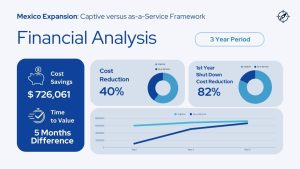
Mexico’s geographical strategic location, population size, and robust tech talent pool make it the preferred nearshore location for North America. As the United States grapples with a tech talent shortage, Mexico emerges as a solution, offering abundant skilled professionals to meet the demand. Additionally, Mexico is also known as a Latin America port-of-entry, given its status as one of the top two largest economies in the region and its Spanish-speaking population, aligning with the preferences of the vast majority of the region. So, while the same city may seem suitable for both strategies, the tech talent shortage in the United States highlights Mexico’s unique advantage as a nearshore destination.
However, it’s crucial to recognize the persistent tech talent shortage in the United States, which has left many companies struggling to fill critical roles. In response, Mexico has emerged as a viable solution to this challenge, offering a rich pool of bilingual tech professionals. While the availability of talent may vary across the country, Mexico’s proximity to the U.S. border and its growing reputation as a tech hub present a compelling opportunity for companies seeking skilled professionals. As companies increasingly look beyond their borders to address the tech talent shortage, Mexico’s strategic advantages position it as an attractive destination for companies looking to bolster their workforce efficiently.
Tech Talent Pool Size
A good starting point when selecting a location is the size of the available talent pool. Just by size, Mexico has several cities that are larger than the total population of other Latin American countries, like Panama and Costa Rica.
For bilingual Tech talent, two factors came into play: The larger the population the higher the probability of finding bilingual talent and the proximity to the U.S. border.
| Rank | Metropolitan area | State | 2020 Census |
| 1 | Ciudad de México | Mexico City | +22 Million |
| 2 | Monterrey | Nuevo Leon | +5.3 Million |
| 3 | Guadalajara | Jalisco | +5.2 Million |
| 4 | Puebla | Puebla | +3 Milion |
| 5 | Toluca | Estado de Mexico | +2.3 Million |
| 6 | Tijuana | Baja California | +2.1 Million |
| 7 | León | Guanajuato | +1.8 Million |
| 8 | Querétaro | Querétaro | +1.5 Million |
| 9 | Ciudad Juárez | Chihuahua | +1.5 Million |
| 10 | Torreón | Coahuila | +1.5 Million |
With the United States, it’s important to note that Mexico is the sole country that effectively shares a direct border with the U.S., making it a prime destination for companies seeking to address the ongoing tech talent shortage. These two factors also play a crucial role in determining how attractive a city is for foreign nationals relocating to Mexico. The larger the city and closer to the border, the more international amenities it will have, facilitating an easier transition for them and their family.
While numerous countries in the Nearshore region may highlight their cultural connections shares a direct border with the U.S. Consequently, this proximity has resulted in a significantly stronger cultural influence over the years.
For example, residents of Tijuana are deeply intertwined with the United States. They frequently visit and often have family members living across the border. As a result, this cultural interaction has a lasting impact on them, shaping their language skills, knowledge of American pop culture, use of slang, and various other aspects of their lives.
In cities in border states, like Hermosillo or Monterrey, there is still a considerable cultural affinity with the United States, stemming from sources such as television, cultural icons, musicians, and sports teams.
This pattern of stronger cultural ties in the northern areas compared to the southern regions also extends to areas such as culinary preferences, vacation choices, and everyday conversations. As companies increasingly grapple with the tech talent shortage, Mexico’s strategic location and cultural ties with the United States make it an attractive destination for tech companies seeking to expand their workforce and address critical talent needs efficiently.
Industries
Selecting the right city, after location size, is the type of industry the company works in. For example, Guadalajara is known for its diversity and a pool of skilled graduates and experienced professionals excelling in software development. And with its large talent pool, should be the ideal location, right? Well, it depends.
If your company is a Systems Integrator that implements ERPs, Mexico City and Monterrey have a much larger talent pool than Guadalajara. Mexico City because of its size and Monterrey because is Mexico’s Industrial Hub, currently attracting most of the nearshoring foreign investment because its booming manufacturing industry. Just in 2023, Tesla, GM, and Kia Motors announced opening their Electric Vehicles production in that region. Which also bolsters the available talent for Industry 4.0.
But if you are a company that is looking to enter the Latina America Market and has an Enterprise Application built for Pharma Companies, then Guadalajara is a good option as well, as Mexico City and Monterrey. Foreign companies should research not just which competitors are already located in the city, but which industries are dominant as well.
Is Mexico City the right choice then? Not necessarily. Aside from the intense competition for talent in the city, if the foreign company insists on having their team work onsite at the office, they will face an exceedingly challenging task of convincing top talent to return to the office due to the city’s widely known traffic congestion. In contrast, in other cities, talent is more amenable to returning to the office, but this is not the case in Mexico City.
Cost-conscious companies can explore smaller cities, some of which are home to highly educated technical talent that often remains untapped, like Hermosillo, which is near the border. While taxes and regulations are generally consistent throughout the country, state-specific factors like payroll taxes and real estate costs can vary.
Conclusion
The advantage of Mexico is that it has plenty of good cities for opening an office, but this is also a disadvantage for foreign companies, as there’s no one-size-fits-all all answer for the best location.
Companies must engage in thorough research and scenario planning in collaboration with a local firm before settling on a specific city. A common approach involves establishing a central office with satellite branches in other cities. This strategy hinges on having a local presence in multiple locations and choosing cities with robust international airports, which should also be subject to careful research. Furthermore, it’s essential to recognize that tech talent has various opportunities, so if your brand lacks recognition or local presence, it’s imperative to devise a strategy that demonstrates your commitment and local presence.
Countries that have a strategic location have a well-established track record of offering soft landing programs to foreign businesses. Leveraging these programs is essential to sidestep prolonged learning curves and avoid unnecessary expenses.



